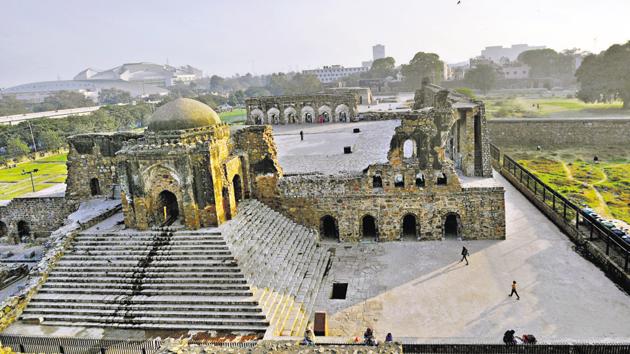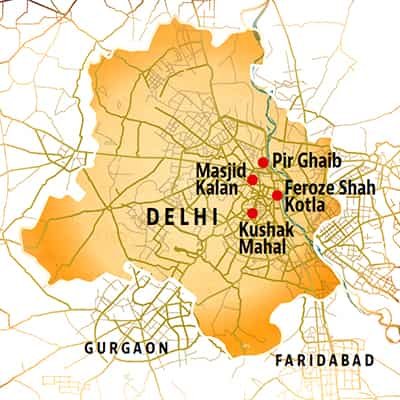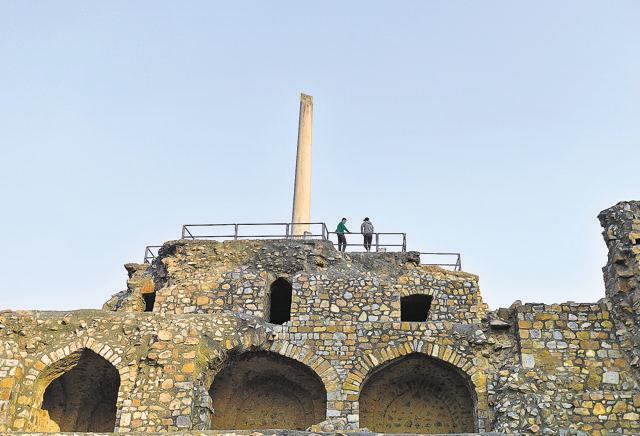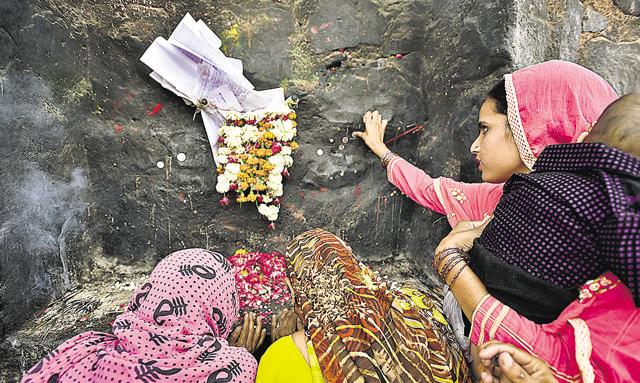Feroze Shah Kotla: A Tughlaq king’s citadel now ruled by djinns
Firoz Shah was the third ruler from the Tughlaq dynasty. He was considered a people’s king and a committed conservationist. He built 30 palaces, 30 towns, 100 bridges and 200 sarais
On a rainy day, the ruins of Firoz Shah Kotla are eerily peaceful, though not completely empty. A pair of chappals rests outside the pyramid-shaped structure known as Hawa Mahal, whose roof features a pillar from Ashoka era. In one of the corridors of the labyrinthine first floor, a woman is rocking back and forth in prayer.


Many locals believe that the three-storey structure is inhabited by a colony of djinns who grant wishes. The most prominent among these spirits is called the “Lath wale baba”, the ‘baba’ of the pillar.
Every Thursday, the faithful throng the ruins, writing their pleas in letters that they tie to the enclosure surrounding the Ashokan pillar, also called the Minar-e-Zarin.
The citadel of Firoz Shah Kotla was built by Firoz Shah Tughlaq, the third king of Tughlaq dynasty in the 14th century. The portrait of the king that we can piece together from different sources is of an able administrator, an indifferent military man, dogmatic in matters of religion, but most importantly, very public-minded. In many ways, Firoz Shah was a people’s king, concerned with the welfare of those he governed, building canals, hospitals, sarais. Even his citadel was less forbidding than the rocky forts of previous Tughlaq kings. While the other forts exist as monuments, the people’s belief in djinns has made Kushk-i-Firoz, as the Kotla citadel was known, a living site.
A builder and a king
In 1354 AD, Firoz Shah abandoned Tughlaqabad and Jahanpanah in Mehrauli, and founded a new city, Firuzabad, on the banks of the Yamuna. The move was necessitated by an acute water shortage in the old city.
Firuzabad spread from Purana Qila to the Ridge toward the north and extended till Raziya Sultana’s grave in Turkman Gate. Firuz Shah’s reign was marked by relative peace, and Firuzabad lacked fortified boundary walls of Tughlaqabad or Lal Kot.

By all accounts, Firoz Shah Tughlaq was a committed conservationist, and an even more passionate builder. During his reign, many monuments or structures commissioned by kings before him were repaired. He repaired the steps of the Tomar-era Surajkund reservoir and the the Western Yamuna Canal, said to have originally been built by Prithviraj Chauhan. In 1368, he undertook repair work on the Qutub Minar and added the two upper storeys.
“Among the gifts which God bestowed upon me, His humble servant, was a desire to erect public buildings,” writes the king in his autobiography, Futuhat-i-Firozshahi.
Apart from Firuzabad in Delhi, he’s credited with establishing three more cities — Hissar-Firoza in Haryana, Fatehbad in Punjab and Jaunpur in Uttar Pradesh. Firoz Shah’s list of completed public works can put present-day civic agencies to shame. He built four canals, 10 public baths, 30 palaces, 30 towns, 100 tombs, 100 bridges, and 200 sarais.
Read more | Tughlaqabad Fort: Of a monarch and a revered Sufi
Among all these, the ruins of Firoz Shah Kotla exercise the most powerful pull among citizens of contemporary Delhi. What survives in the fort complex are its outer walls, the Jama Masjid (Kotla Masjid) built on a raised structure with cells underneath, the Hawa Mahal, a baoli and the ruins of three courts, one for the nobles, one for personal attendants and one for the common public. Firoz Shah Kotla became the prototype for later Mughal forts.
Asif Khan Dehalvi, who runs Delhi Karavan and has conducted hundreds of heritage walks, says the Kotla ruins are his favourite site. “People are fascinated by this place and the ruins are the perfect backdrop to tell a story”, he says. “I start by telling them the history and then, of course, about the djinns.”
A Kotla of djinns
Anand Vivek Taneja, a professor at Vanderbilt University and author of a book about djinns — Jinnealogy: Time, Islam and Ecological Thought in Medieval India — has studied the Firoz Shah Kotla site for years, gathering first-hand testimonies from the people who frequent it.
“People believe that it is a dargah, just that the saints are not humans, but djinns,” says Taneja. Dargahs are places where a saint is buried, but a mausoleum is not a prerequisite. “Theologically, people believe a dargah is a place where saints are present, or ‘hazir’, and this can be in the form of visions or dreams, or in this case, djinns,” says Taneja.
- In 1536 AD, the pillar was brought to Feroze Shah Kotla wrapped in bales of sembal cotton, wild grass and animal skin, secured with ropes, being transported on a 42-wheel cart. Each wheel attached to a strong rope; each rope pulled by 200 men. A barge made from several huge boats transported it across the Yamuna to Firuzabad.
- Engineers first constructed a pyramidlike structure to house the 13-metre pillar, and then used an inclined slope to raise it perpendicular. The pillar was named ‘Minar-i-Zarin’. Feroze Shah invited scholars to decipher the edicts inscribed in Pali and Brahmi script.
- The Ashokan pillar stands today exactly where it stood more than 600 years ago.
- Firoz Shah Tughlaq was fond of hunting and has left behind hunting lodges in Delhi. One of the hunting lodges is said to be at Pir Ghaib, part of the Bada Hindu Rao complex, where one of the Ashokan pillars was erected. Kushak Mahal, a shikargah built in the mid-14th century, stands within the Teen Murti Bhavan complex. The structure is built on a platform and made from rubble masonry – the sultan and his entourage would stay for days at a time here during their hunting expeditions.
The practice of writing formal petitions to the powerful Sultans or Sufi saints, was prevalent under the Delhi Sultanate. When the devotees at Firoz Shah Kotla address their petitions to the djinns, they draw upon this tradition, but also their experiences with modern bureaucracy. “The use of modern technology, photocopying petitions as if they are addressed to multiple bureaucratic departments, using Voters’ ID…this is a new revival of an old form in a new manner,” says Taneja.
If the petition-writing has a historical precedent, the site’s association with the sacred has an interesting history as well. A popular oral legend connects the djinns to a man named Ladoo Shah in the 1970s. “People say that Ladoo Shah was a fakir from Old Delhi who shifted to the ruins of Kotla after he was rendered homeless due the demolitions at Turkman Gate in 1976,” says Rana Safvi, who writes a popular blog on Delhi’s heritage and wrote a book on Mehrauli’s history. According to devotees, says Safvi, “Ladoo Shah had djinns under his control and his mureeds started visiting the Kotla.”
In the version of the story that Taneja tells, the djinns fell in love with Ladoo Shah, becoming his aashiq (lover/s) and bestowing on him the gifts of healing. “Ladoo Shah popularises the site in the seventies, asking people to pray in the mosque,” he says.
But while the djinns became inextricably linked to the site in the 1970s, Taneja’s research into Archaeological Survey of India records shows that even as early as the 1920s, people venerated the ruins and stuck coins to the walls, a practise that continues till date.

Like other sacred places, it is word-of-mouth testimonies and sheer belief that makes people of all stripes come to Kotla with hopes of prayers being answered. Safvi says a shopkeeper from Old Delhi told her that every Friday, he distributes biryani to the folk who gather at Kotla, because the djinns have answered so many of his prayers.
Today, the Kotla ruins make it to lists of the most haunted places in India. “What the upper classes call ‘haunting’ is a very matter-of-fact occurrence for the local people. They believe in the presence of an invisible world, and that in some places it is more apparent than the others,” says Taneja.
Stay updated with all top Cities including, Bengaluru, Delhi, Mumbai and more across India. Stay informed on the latest happenings in World News along with Delhi Election 2025 and Delhi Election Result 2025 Live, New Delhi Election Result Live, Kalkaji Election Result Live at Hindustan Times.
Stay updated with all top Cities including, Bengaluru, Delhi, Mumbai and more across India. Stay informed on the latest happenings in World News along with Delhi Election 2025 and Delhi Election Result 2025 Live, New Delhi Election Result Live, Kalkaji Election Result Live at Hindustan Times.





